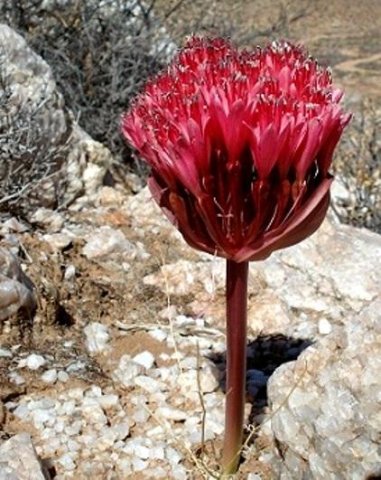Brunsvigia pulchra

Brunsvigia pulchra is a bulbous perennial of the Amaryllidaceae family. Previously known as Boophone pulchra, the specific epithet, pulchra, a Latin word meaning beautiful, places the emphasis appropriately in the choice of a named attribute.
The plant annually grows five to seven prostrate, broad, tongue-shaped leaves with red margins. The leaf arrangement is distichous, on top of each other in two opposing arrays. The deciduous leaves do not coincide with the inflorescence, arriving later as the plant is hysteranthous.
In flower the plant measures 30 cm in height. The individual flowers are funnel-shaped on sturdy brown pedicels, all bunched closely together, pointing upwards. The plant in picture presents a straight, erect scape and bracts that still clutch the flowers around the base. Some anthers on straight, pink, bunched filaments can be seen protruding well above the outwardly angled tepal tips.
The distribution of Brunsvigia pulchra is restricted to an area in the west of the Northern Cape, in the south of the Richtersveld and Namaqualand to the Kamiesberg. This plant was photographed near Springbok.
The habitat is characterised by gravelly slopes of granite derived soil, sometimes in montane renosterveld. The population is stable although species is rare.
Rain stimulates the appearance of leaves, while the flowers arrive only later in this hysteranthous species. The preparatory growth of leaves equips the large perennial bulb with the resources for producing a robust inflorescence during the following autumn.
In years of good rain the number of leaves will be more, up to seven and they may be larger. In drier seasons the leaves are fewer and consequently, the number of flowers in the umbel. In years when the winter rain is inadequate to trigger sufficient growth, the bulb does not produce an inflorescence at all.
A few-flowered inflorescence may carry infertile flowers, while a flourishing, big one tends to self-fertility (Williamson, 2010; www.pacificbulbsociety.org; http://redlist.sanbi.org).

